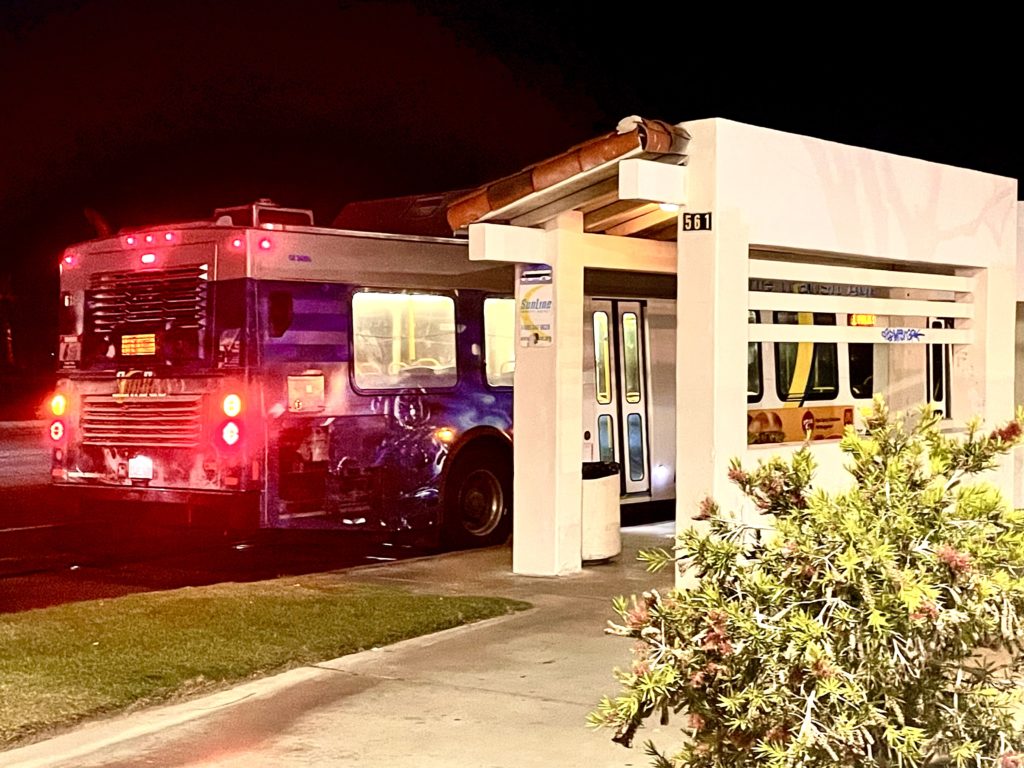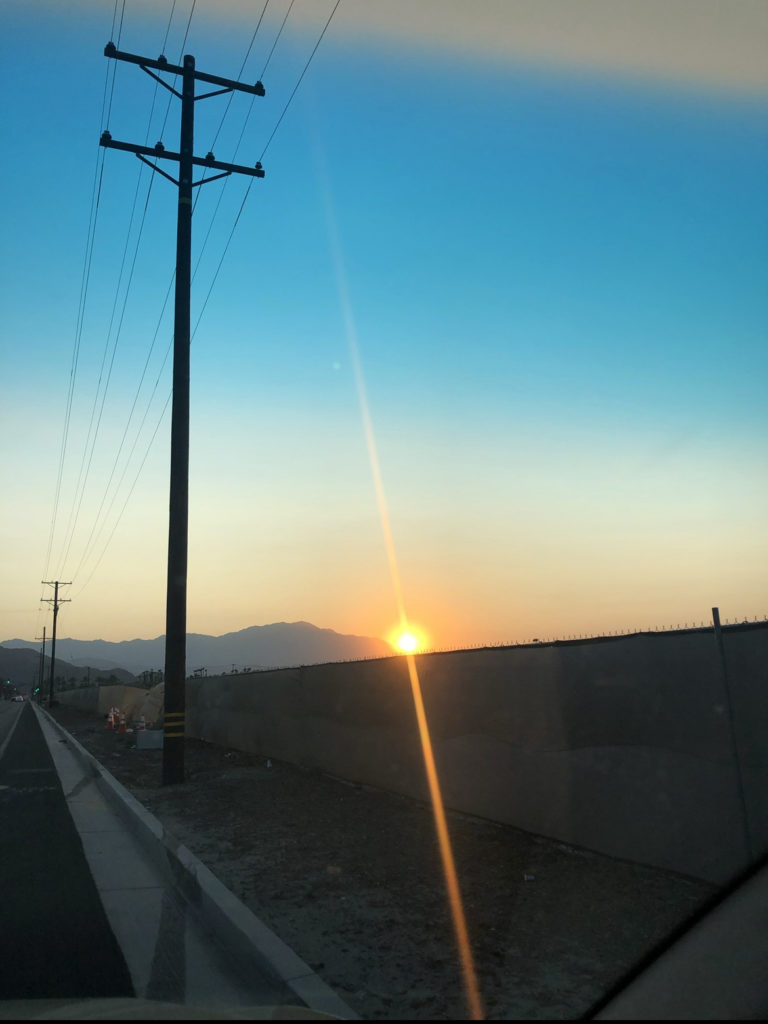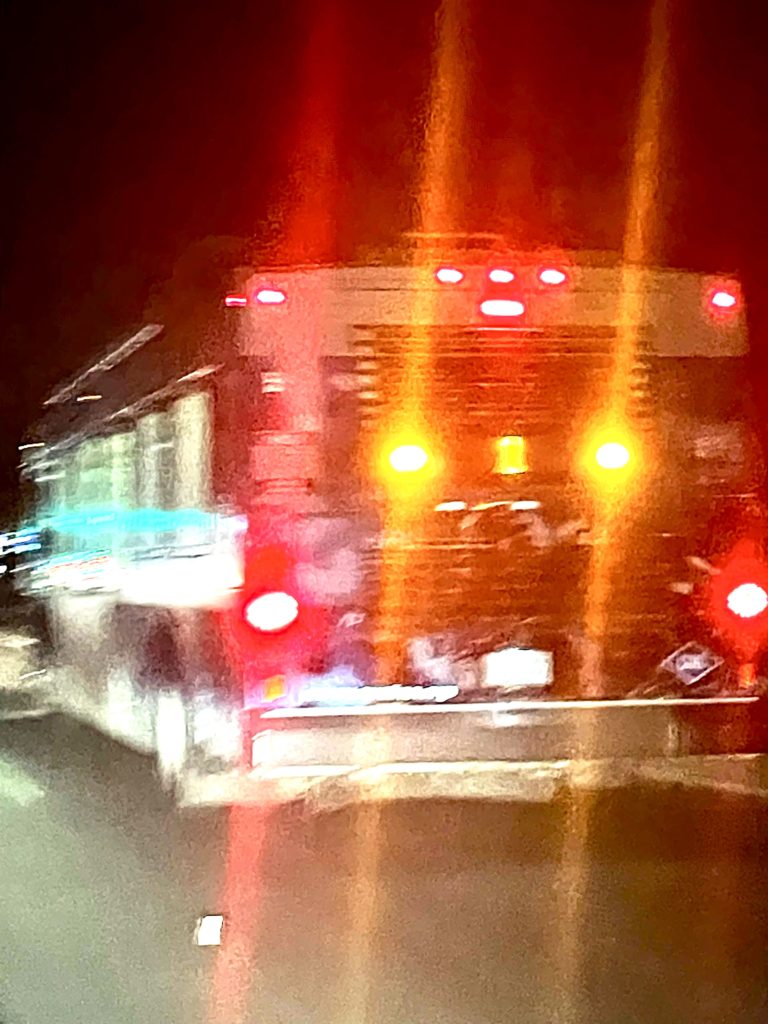
In my experience, you can’t rely on the bus wheels to get you where you need to go. In the Eastern Coachella Valley, it means waiting in the heat from 45 minutes to an hour, since some bus stops don’t have shade and none have water fountains. One particular day, I had run out of water on my walk home from the bus. I had already waited for the bus in the scorching heat for about an hour. I felt my vision darkening like a tunnel, and I was sweating tremendously, feeling weak. I knew I was getting dehydrated, but I just wanted to get home and rest from school. I struggled to breathe as the sun beamed on my head, worsening my migraine in the suffocating heat. My nostrils dried up and began to bleed. My skin was clammy and pale. I felt as if I was about to pass out. I raced home with all of the strength I had in me, stopping my nosebleed with my favorite pink cardigan.
When I got home, I rushed inside and turned on the shower, cooling myself from the heat without even bothering to take off my shoes. I passed out on my bed for a few hours before waking up in a haze.
Eastern Coachella Valley summer temperatures make a bad bus system dangerous. We get the short end of the bus seat, with inconsistent routes, a lack of buses showing up on time, and closed bus stations in vital areas. Taking the bus is time-consuming and many residents in the eastern part of Coachella Valley, including Mecca, Coachella, and Thermal, have fewer buses. The Sunline Transit Agency fails to include consistent routes, favoring urbanized wealthy areas like Palm Desert and Palm Springs. Worst of all, some of our bus stations don’t have shade in a place where the sun beams all day. If you rely on the Sunline Transit, then you know firsthand our desert is suffering the effects of global warming at a fast rate. With temperatures reaching up to 93 in spring, waiting for the bus is not just an effort – it’s a constant struggle if it’s your main mode of transportation. Many spend hours waiting in the heat, risking heat exhaustion.
The Sunline Transit Agency is trying to address these issues by creating the Sunline Refueled Short Range Transit Plan. This plan would create a consolidated fixed route system, a network that should offer the increased frequency of buses flowing in and consistent bus service along with improved connections and fewer transfers. These improvements should provide access to schools and healthcare locations, job centers, and entertainment. An additional service, called the Sunride Service, will pick up residents and drop them off at the nearest bus stop via an app. There will also be a route that will stretch along Palm Springs to Coachella along Highway 111 with fewer stops, allowing for reduced travel time for people taking the bus from those locations.

This plan looks good in theory but where is the momentum to see that change? It fails to provide clear information and lacks follow-up plans for each initiative, stating each time the project hasn’t been funded and the implementation date has yet to be determined. How beneficial are these plans if the implementation date has yet to be determined and there is no funding? When people can’t arrive on time to their jobs, schools, and doctor appointments, their opportunities are reduced. The purpose of the Sunline Transit Agency is to be a vehicle of mobility. When it fails to live up to the promised improvements, it reinforces poverty and lack of opportunity.
These issues aren’t just going on here in the Valley, they also happened in Fresno and San Mateo. In 2017, the City of Fresno conducted a study called the fixed route system. It surveyed the routes that were being used and the routes that weren’t in efforts to improve the bus system. Based on the findings of this study, they planned to update and extend routes to make routes faster.
Sher Moua, a Program Director at Youth Leadership Institute, along with youth and adult allies, started the What the Fax coalition to ensure that college students and people utilizing the bus have a say in the improvements being made to their local bus agency. One of the youth in the What the Fax coalition took the study and rode the bus. “If you were to drive from our office to the local community college it took 10 minutes tops. That’s with traffic. It took him much longer than that. When he got to the office, he was sweating. He was tired,” Sher said.
This inspired What the Fax to take action. The majority of the coalition members were living in South Fresno, so they decided to take the bus from parts of South Fresno to a central location. They took buses from South East Fresno, South Central and South West Fresno, designating a time to meet at the Fresno River Park, a commercial spot with restaurants, businesses, and shops. “One of our group was 30 minutes late, and the reason they were late is that they missed a transfer…So they had to wait for the next bus to get the transfer…I can only imagine how often this happens,” said Sher.
San Mateo County youth recounted similar experiences relying on the bus as a way to raise awareness on how transportation is an equity issue. One student said that the bus is unreliable, the timing is always off and whenever she does rely on the bus, she is late for school. Another student explained how the bus can be up to 45 minutes late. A coalition of local organizations and youth, called TEAMC, did research on the demographics of who was utilizing the bus: “San Mateo County is a very wealthy county, but the folks that were using the bus and the folks that depended on the bus to get to school, to get to work, anywhere….75% of them were people of color. Almost all of them had an income of less than $40,000 when the average income in a place like San Mateo County is $120,000. For the folks that were utilizing these services, if that service wasn’t there, then they could lose their job. There were real-time consequences for them,” Montze Garcia Bedolla, former TEAMC coalition leader, and yli Program Director, said.

These failures of public transportation happen across different communities in California, which means that this issue is systemic. People who rely on public transportation are primarily people of color and low-income people. People who can’t afford Uber or Lyft. People who can’t afford their own car. People who are already underrepresented. This is an environmental and social justice issue.
What the Fax teamed up to go to meetings and hearings about what needed to change to improve their bus agency. They went to a series of community workshops, and did their own survey, going to bus stops to speak with bus riders. They also met with bus agency consultants, and with city council members and the mayor. “During the budget process, we attended those meetings, and presented our recommendations,” said Sher. As a result, the agency committed to ensuring wifi on the whole fleet of buses within the next 2-3 years. They’re continuing their campaign for transportation justice, to help fix sidewalks and advocating to make all buses free for students.
In San Mateo, TEAMC youth also identified public transit solutions, like adding shelters for the people, more access for the elderly and disabled, and having outlets and portable chargers. TEAMC met every single day with Samtrans, “making sure that young people knew what was happening at every step of the way when it came down to proposing an expenditure plan, which was basically how we wanted to see the money split up,” said Montze.
In 2018, they had the opportunity to do a ballot measure in order to raise revenues for the bus agency. Now, every year there’s about 88 million in revenue that is going to transportation improvements in San Mateo County. These improvements directly included the voices of youth and environmental justice organizers. “On the other side of the coin, TEAMC activated civic engagement for people who wouldn’t usually have a reason to vote,” said Montze. “Activating a whole bunch of 17-year-olds, 18-year-olds, 19-year-olds. This is the first time that they were going to vote. And if they’re going to vote for something, they should vote for this. And I believe in my heart that that’s the reason why this passed, because 67% of the county needed to vote for this. It wasn’t a simple majority with 50%. That’s so many people.”
If San Mateo and Fresno could do it, so can the Coachella Valley, and it’s what we need. In order for the Sunline to have more riders, the bus needs to stop more for their riders, with more frequent stops, fewer transfers, and routes designed by people who take the bus. They should also provide water fountains, shades, and charging plugs for youth to charge their phone or laptop. An app to show how soon the bus will arrive would be very useful.
I don’t want to hear another story of someone getting heat exhaustion on their way to the bus. The community – and especially those who use the bus most, like youth, people with disabilities, and low-income people – in the Coachella Valley should participate in deciding how money is split up to improve the bus system. The problem is not that there’s not enough money to fund a better transportation system: it’s where that tax money is going and how it is being utilized.
It’s time for youth to be at the table. We need to invest in the public transportation system, and the youth should be the driving force to fix that. The green light.
